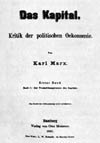

A real machinery system, however, does not take the place of these independent machines, until the subject of labour goes through a connected series of detail processes, that are carried out by a chain of machines of various kinds, the one supplementing the other. Here we have again the co-operation by division of labour that characterises Manufacture; only now, it is a combination of detail machines. The special tools of the various detail workmen, such as those of the beaters, cambers, spinners, &c., in the woollen manufacture, are now transformed into the tools of specialised machines, each machine constituting a special organ, with a special function, in the system. In those branches of industry in which the machinery system is first introduced, Manufacture itself furnishes, in a general way, the natural basis for the division, and consequent organisation, of the process of production. Nevertheless an essential difference at once manifests itself. In Manufacture it is the workmen who, with their manual implements, must, either singly or in groups, carry on each particular detail process. If, on the one hand, the workman becomes adapted to the process, on the other, the process was previously made suitable to the workman. This subjective principle of the division of labour no longer exists in production by machinery. Here, the process as a whole is examined objectively, in itself, that is to say, without regard to the question of its execution by human hands, it is analysed into its constituent phases; and the problem, how to execute each detail process, and bind them all into a whole, is solved by the aid of machines, chemistry, &c. But, of course, in this case also, theory must be perfected by accumulated experience on a large scale. Each detail machine supplies raw material to the machine next in order; and since they are all working at the same time, the product is always going through the various stages of its fabrication, and is also constantly in a state of transition, from one phase to another. Just as in Manufacture, the direct co-operation of the detail labourers establishes a numerical proportion between the special groups, so in an organised system of machinery, where one detail machine is constantly kept employed by another, a fixed relation is established between their numbers, their size, and their speed. The collective machine, now an organised system of various kinds of single machines, and of groups of single machines, becomes more and more perfect, the more the process as a whole becomes a continuous one, i.e., the less the raw material is interrupted in its passage from its first phase to its last; in other words, the more its passage from one phase to another is effected, not by the hand of man, but by the machinery itself. In Manufacture the isolation of each detail process is a condition imposed by the nature of division of labour, but in the fully developed factory the continuity of those processes is, on the contrary, imperative.
A system of machinery, whether it reposes on the mere co-operation of similar machines, as in weaving, or on a combination of different machines, as in spinning, constitutes in itself a huge automaton, whenever it is driven by a self-acting prime mover. But although the factory as a whole be driven by its steam-engine, yet either some of the individual machines may require the aid of the workman for some of their movements (such aid was necessary for the running in of the mule carriage, before the invention of the self-acting mule, and is still necessary in fine-spinning mills); or, to enable a machine to do its work, certain parts of it may require to be handled by the workman like a manual tool; this was the case in machine-makers’ workshops, before the conversion of the slide rest into a self-actor. As soon as a machine executes, without man’s help, all the movements requisite to elaborate the raw material, needing only attendance from him, we have an automatic system of machinery, and one that is susceptible of constant improvement in its details. Such improvements as the apparatus that stops a drawing frame, whenever a sliver breaks, and the self-acting stop, that stops the power-loom so soon as the shuttle bobbin is emptied of weft, are quite modern inventions. As an example, both of continuity of production, and of the carrying out of the automatic principle, we may take a modern paper mill. In the paper industry generally, we may advantageously study in detail not only the distinctions between modes of production based on different means of production, but also the connexion of the social conditions of production with those modes: for the old German paper-making furnishes us with a sample of handicraft production; that of Holland in the 17th and of France in the 18th century with a sample of manufacturing in the strict sense; and that of modern England with a sample of automatic fabrication of this article. Besides these, there still exist, in India and China, two distinct antique Asiatic forms of the same industry.